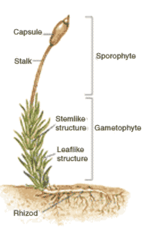Moss
| moss | |
|---|---|
| Kingdom: | Plantae |
| Phylum: | Bryophyta |
Classes
- There are three different classes of mosses within the phylum Bryophyta:
- Peat Mosses
- Sphagnidae
- Granite Mosses
- Andreaeidae
- True Mosses
- Bryidae
- Mosses are a group of small, non-vascular, plants that are classified as Bryophytes. Other Bryophytes includes liverworts and hornworts, and they all share a lack of vasculature and reproduction via spores with a reliance on water to transport the sperm. They are typically 0.2–10 cm tall. Mosses can commonly be found forming dense mats in wet and/or shady habitats. Some species are extremely resilient and tolerate many toxins, which is why they can also be found in a variety of areas including: urban brownfields, the cracks of roadways, and on the sides of buildings. Mosses provide a food source and habitat for macro and micro invertebrates and also create microhabitats that are essential to some species of soil arthropods [3].
Structure

- Mosses lack vascular tissue, which is what other plants use to transport water and nutrients from their roots to their leaves. Since they lack this tissue, their anatomy is dissimilar to more morphologically complex plants. Instead of roots, members of Bryophyta have rhizoids, which hold their vegetative structures onto the substrate that they are growing on. Without vascular tissue, water is transported from cell to cell by diffusion, which is why these plants are so small. The gametophyte is the non-reproductive vegetative structure that carries out photosynthesis. The sporophyte is the reproductive structure that is essential to the dispersal of spores [1].
Life Cycle

- Mosses have two parts to their life cycle. The first stage is the gametophyte, the stage in which mosses will spend the majority of their life. When haploid spores germinate, they grow and mature, eventually developing male and female reproductive structures. The male structure is called the antheridia and produces sperm, while the female structure is called the archegonia and produces egg cells. The haploid sperm will swim through water to the archegonia (which releases a chemical signal to attract them), where the eggs will be fertilized and develop into diploid structures. This begins the sporophyte life stage. The sporophyte reproduces and via meiosis to create haploid spores, and the life cycle starts over again. Unlike seed bearing plants, water is essential in the reproduction of moss, which is why it must grow in moist environments [4].
Environmental Role
- Mosses play an vital role in stabilizing soil, reducing erosion, and reducing the risks of flooding by absorbing excess water. Their rhizoids can hold on to clay, gravel, and sandy soil substrates. Along with absorbing moisture, mosses are an important carbon sink and could potentially play an important role in combating climate change. Additionally, mosses can filter other pollutants like excess sediment and salt used on roadways. Within the local environment mosses also have the ability to create humid microhabitats. [2] In some boreal and arctic ecosystems mosses are the primary plant type and are responsible for establishing soil layers, providing nutrients and habitats for new seeds to germinate, and providing areas for microinvertebrates to thrive [5].
References
- [1] Crandall-Stotler, B. J., and S. E. Bartholomew-Began. 2007. Morphology of Mosses (Phylum Bryophyta):3–13.
- [2] Crooks, V. 2021, February 22. Bryophytes. Text, Smithsonian Tropical Research Institute. https://stri.si.edu/story/bryophytes.
- [3] McHale, E. 2020, May 23. 7 interesting things about moss | Kew. https://www.kew.org/read-and-watch/moss.
- [4] Carter, J. S. 2010, September 12. Mosses and Ferns. https://biologyclermont.info/wwwroot/courses/lab2/mosses%20intro.htm.
- [5] Turetsky, M. R., B. Bond-Lamberty, E. Euskirchen, J. Talbot, S. Frolking, A. D. McGuire, and E.-S. Tuittila. 2012. The resilience and functional role of moss in boreal and arctic ecosystems. New Phytologist 196:49–67.